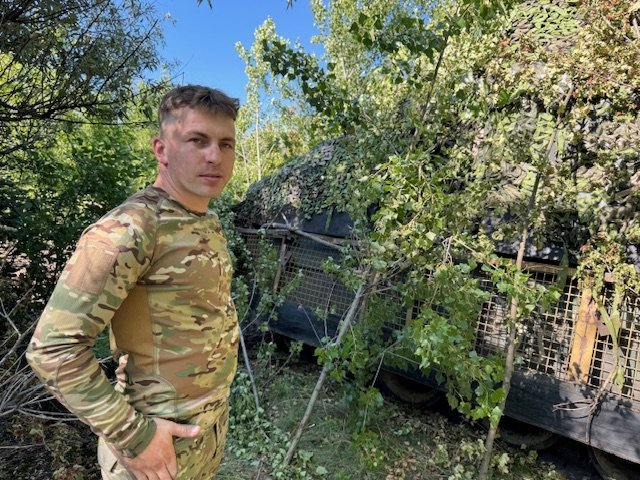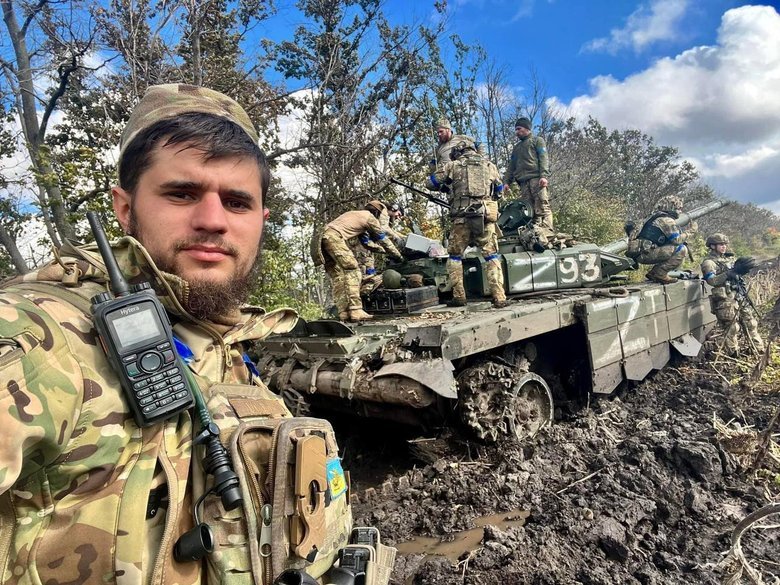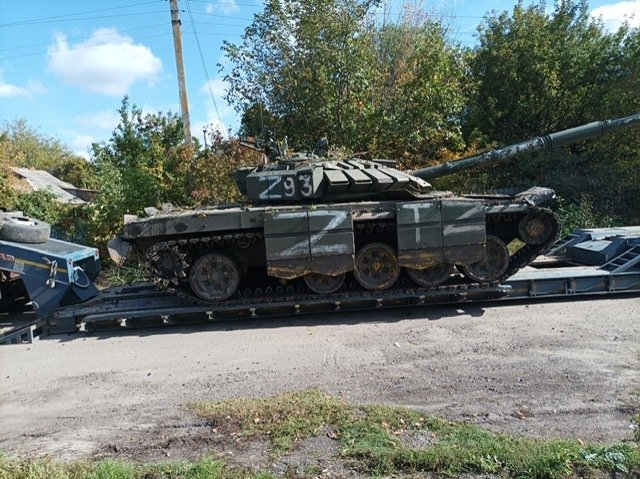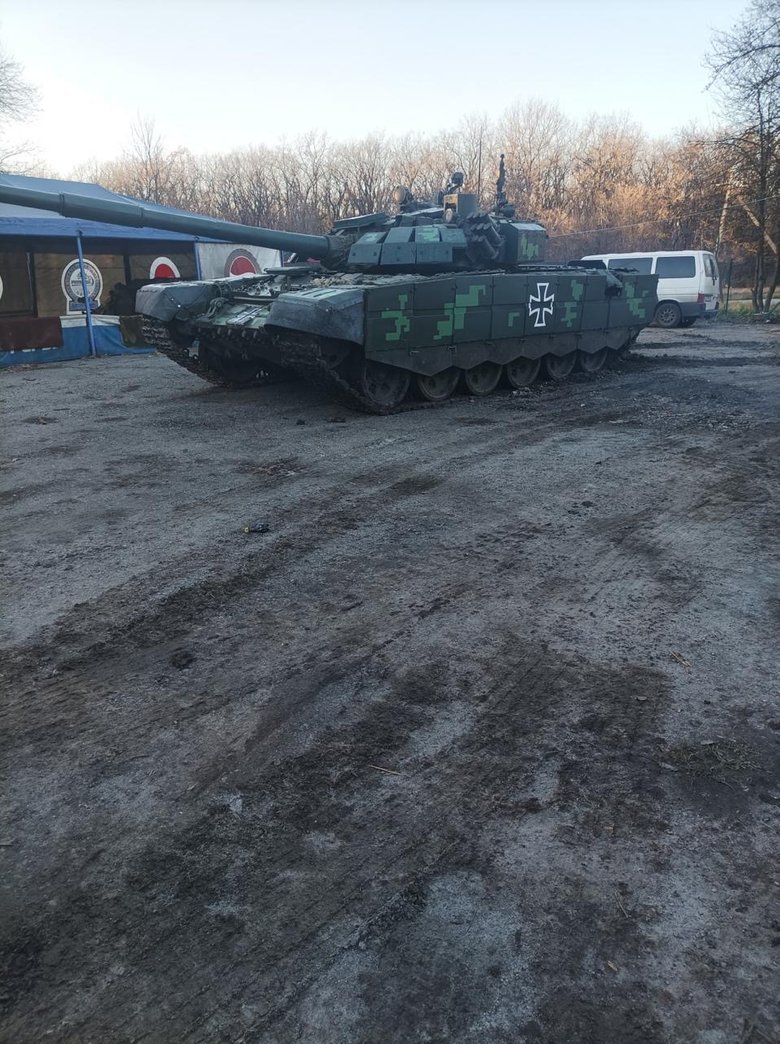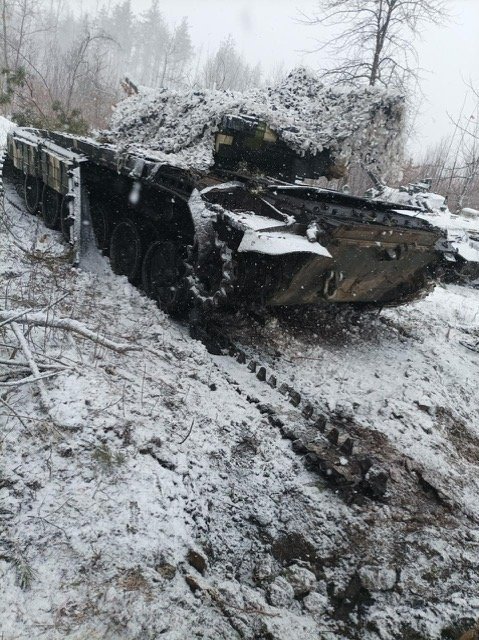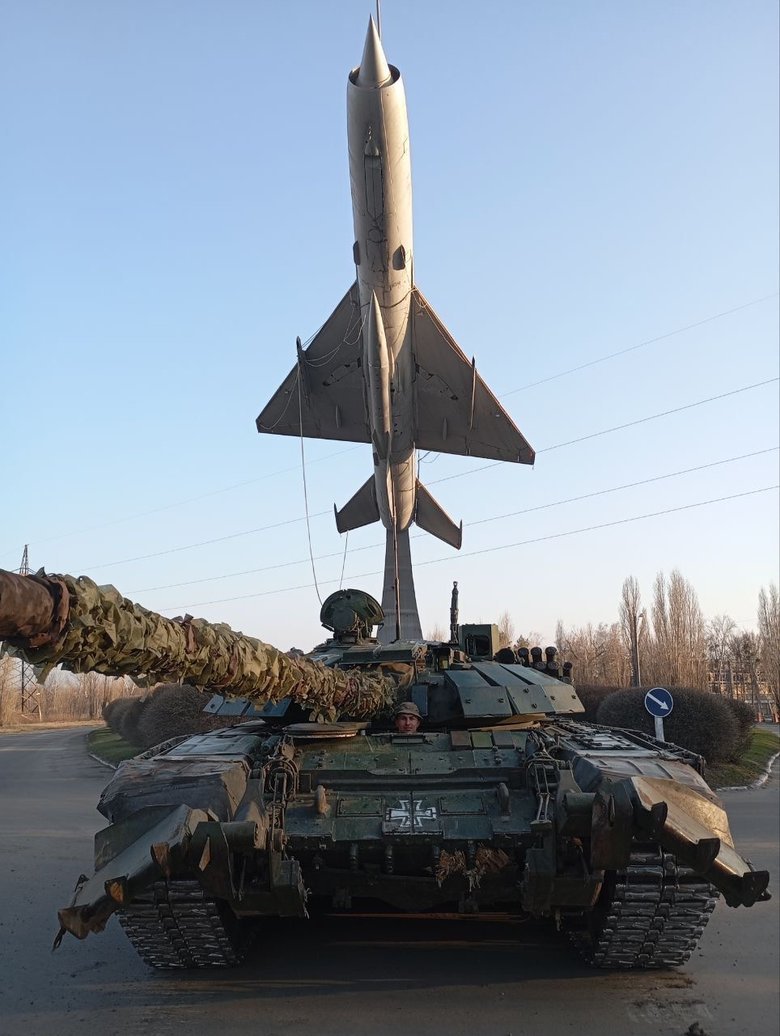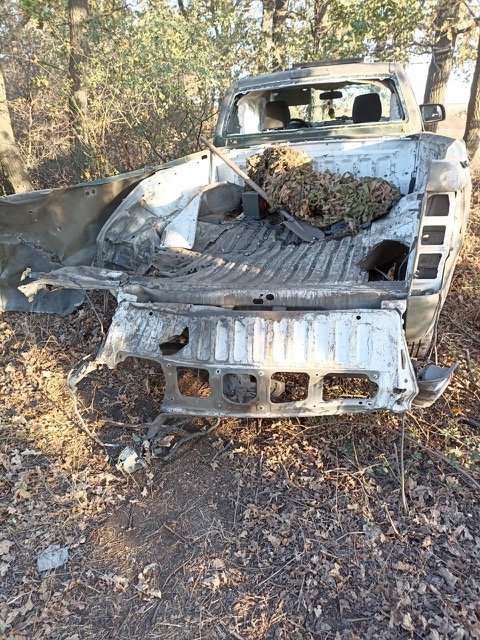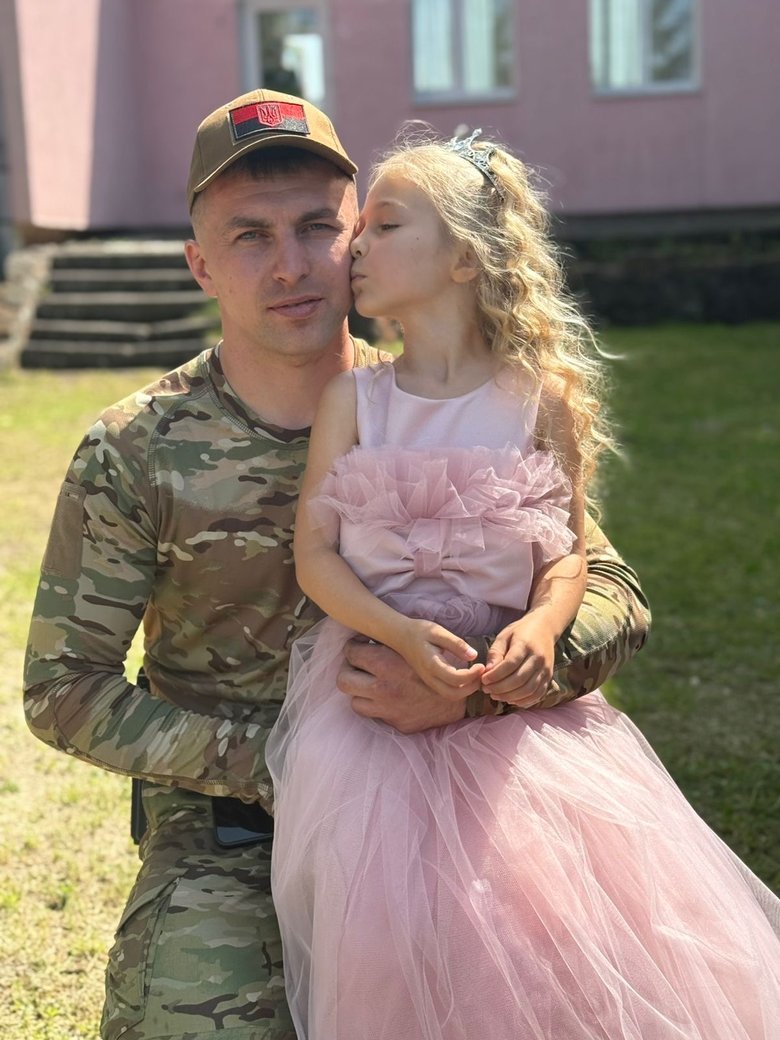"We fight enemy with Russian equipment" Volodymyr Lutsyk leads only tank company composed solely of captured equipment
In the spring of 2022, the unit commanded by Dmytro Kotsiubailo captured its first trophy tanks. The fighters pulled them out from the Bilohorivka crossing. Later, they secured "a few more" tanks following the liberation of Izium, Borova, and Kupiansk. Most importantly, all of these Russian tanks are still operational, delivering painful blows to their former owners.
A tank concealed in a tree line was located and hit by 12 FPV drones. But it managed to drive out under its own power. The only tank company fighting exclusively with captured Russian tanks is part of the 1st Assault Regiment, which was originally formed by the legendary Da Vinci.
Until now, Volodymyr Lutsyk, commander of the tank company of the 1st Assault Regiment named after Hero of Ukraine Dmytro "Da Vinci" Kotsiubailo, its first legendary leader, had never given an interview. I was fortunate not only to speak with him, but also to see the very tanks that were captured back when the unit was essentially still a volunteer formation. There are seven of them. All are operational. All are in use. Moreover, this remains the only tank company in the Armed Forces of Ukraine formed entirely from captured vehicles. That was Da Vinci’s vision and he would undoubtedly be proud of his unit.
Da Vinci always dreamed of having his own tanks. When a mechanized brigade left him a couple of armored vehicles for safekeeping, he was genuinely delighted, showing off his "fleet" to those he trusted, saying: "One day I’ll have my own armor. And tanks, too." At that moment, his eyes lit up. I recalled that conversation in the autumn of 2022, when Da Vinci sent me a message: "We pulled out a Russian tank. Now my unit has armor!" After the Kharkiv operation, when significant territory was liberated, Da Vinci’s unit, by then already integrated into the Armed Forces, finally acquired armored equipment. Back in 2014, unarmed, they fought to seize rifles and machine guns on the battlefield. Now, as the war has grown in scale, they have "re-equipped" themselves with a Solntsepyok, tanks and MT-LBs...
"ARE YOU READY TO GO AND TAKE AN ENEMY TANK? I'M ALWAYS READY FOR THAT!"
- "The first equipment we captured in Bilohorivka was one tank, two IFVs and one MT-LB," says 29-year-old Volodymyr Lutsyk, commander of a tank company. "How did I end up in Da Vinci’s unit? I had combat experience, as I served in the 24th Brigade until 2019. When I was discharged, I promised our then-commander Serhii Mazorchuk that if necessary, I would return immediately. I kept my word, during the full-scale invasion, I joined the 1st Battalion of the 24th Brigade, which was stationed in Popasna, Luhansk region. Everyone who served with me knows I love military hardware and know my way around it. As a kid, I used to take motorcycles apart and put them back together. In the army, I worked on an IFV. "It’s more or less the same as a tank, the IFV has a steering wheel, while the tank runs on levers." When the events at the Bilohorivka crossing were unfolding, Yurko Kapusta rushed up to me, by that time he had already joined Da Vinci’s unit: "The Russians have pulled back, there’s equipment. But nobody has cleared the area yet. Are you ready to go retrieve a tank?" And I’m always ready for that. Kapusta and Da Vinci planned the operation. And so we went to collect the trophies.
That very first Russian tank was pulled out by Volodymyr Lutsyk together with Yurii Kapustiak.
Another fighter from the 24th Brigade, callsign Brem, came to help us, he brought a winch, because we couldn’t tow the armor out ourselves, it was too heavy. But Kapusta and I managed to start up the tank, and it drove under its own power all the way to Bakhmut. It even had its ammunition load, the vehicle was fully stocked. After that, the idea came up to push further, to see what else was left at the crossing and whether anything else could be recovered and put to use. So we went! And sure enough, there was a lot of abandoned equipment. Some vehicles couldn’t move, others were completely wrecked or too heavily damaged to make recovery worthwhile. We tried to do everything quietly, carefully. In some cases, we replaced the batteries. Da Vinci was up ahead of us, and at his signal, just a wave of the hand, two IFVs rolled out. I was at the controls of one, Kapusta in the other. Later, those very vehicles were used for training fighters how to drive.
- Did the enemy hear you?
- No doubt. We were right by the crossing.
The same tank after its restoration
- When did they start persuading you to transfer into Da Vinci’s unit?
- Back when we were still with the tank. He kept saying: if we manage to pull the tank out, we’ll arrange any transfer, just come join us. And once we recovered the other armor, Kapusta also said: "Send over your papers, we’ll take you in." But I asked Dmytro and Yurko to speak with my battalion commander — Serhii Mazorchuk. I still reported to him. And I didn’t want to let him down. He was counting on me. But Serhii agreed.
While Da Vinci’s unit was still formally part of the Special Operations Forces, it was not possible to form a tank company, that kind of structure simply isn’t foreseen in that branch of service. Yet the volunteers already had six armored vehicles!
- "We collected them wherever we could," Volodymyr continues,"In liberated Izium, everything was littered with Lepestok mines. It was dangerous. Vehicles moving around there regularly got blown up on them… That’s where we found an abandoned tank in the woods. When leaving it, the Russians deliberately damaged the wiring so we couldn’t use it. But we fixed everything.
For the assault on Borova, units of the 1st Separate Assault Battalion set out but it turned out the Russians had already fled, leaving behind whatever they could. We moved in right after them. There’s a video showing Da Vinci being the first to drive into the village after its liberation. To check what was ahead, we launched a drone. In a sunflower field we spotted two tanks, about a kilometer apart. We went to them together with scouts and carefully inspected them. One of them started up. It was an even newer modification of Russian tank design. The only thing missing was a track, it had slipped off. The Russians had tried to fix it, but assembled it incorrectly, botched the repair, and ran. So we finished the job properly. In the other tank, we found a grenade without a pin stuffed under the driver’s seat. If we had lifted the seat, it would have exploded. Luckily, we spotted that "gift." By then, we already knew to look for such "surprises", they had left them in the vehicles at Bilohorivka too. That’s why we carefully checked every machine abandoned by the Russians."
In the autumn of 2022, Da Vinci was offered the chance to form a battalion within the 67th Brigade, subordinated to the Ground Forces. In that case, his battalion could become mechanized and build a unit based on captured equipment.
"Da Vinci then tasked me with preparing two tank crews," Volodymyr continues. "Vovka, a fighter who had served for many years in Dmytro’s volunteer unit, was appointed commander of the tank company. Together with him, we restored the equipment so that everything was operational and could be used against the enemy. The battalion began recruiting from among mobilized soldiers. I took one of them as a gunner, today he is already a tank commander. I trained another, a mechanic, from our own fighters, those who had long served with Da Vinci. The company as a whole was formed from those volunteers who had already been fighting alongside Vovka under Da Vinci. This is how we built tank crews. We restored two tanks during the time the 67th Brigade was being formed at the training ground, specifically our 1st Separate Assault Battalion. We trained ourselves and trained others using those two restored trophy tanks. By the time the brigade left the training ground, our 1st tank platoon had been prepared and formed, with three tanks as prescribed."
At first, they were held in reserve, but were not deployed, in the Lyman area there are many forests, where artillery was used more extensively. But there they captured another Russian tank.
"I STARTED TOWING THE TANK AND HIT A MINE MYSELF"
- "The combat engineers were clearing the area and found an abandoned enemy tank and a IFV", Volodymyr continues. "On hearing this, Da Vinci immediately asked whether the vehicles could be recovered. Wolf and I drove out and inspected everything on site. We realized the vehicle had hit a mine and thrown a track, that’s why they’d left it. We decided to recover that abandoned one with our tank. We hooked it up, and I hit a mine."
- Was anyone hurt?
- No. I was inside the tank myself. The others were standing a bit farther away. Da Vinci was there too, he was always there! He could never stay away from where someone was about to work. It was winter, lots of snow. Slippery. I couldn’t pull that tank right away. First we had to break it free, pull it forward, then drive around, hook up from the rear and tow it out. When I was already trying to pull it, the explosion happened. Luckily, no one was injured. Our tank only threw a track.
It was with this tank that Volodymyr was towing yet another abandoned Russian vehicle when he himself hit a mine.
"We were lucky it was snowing, Russian ‘wings’ weren’t flying and couldn’t see us fussing around there. We had to replace as many as twelve track links. I’d been stockpiling spares all along, just in case, and by then we’d built up enough of what we needed. So we had everything at hand. One call to the base, they brought the track shoes, and we put the tank back on its tracks. We managed to hook it up and haul it out. Its road wheels were damaged. We kept it and got it ‘back on its feet’ with our own hands. By that time, I was already a tank commander, but I was driving as a mechanic and recovering vehicles. Nothing’s changed even now, though I have people under me. If needed, I go out with the crew. The day after we pulled the tank out, we evacuated the IFV as well.
"We got the recovered tank running: fixed a few issues and it started. The fire-control system worked too. All that was left was to repair the road wheels. Since we weren’t being tasked for combat at that moment, we had time to restore the vehicles which is exactly what we did. This was already the seventh tank.
"While we were restoring the track, two guys who were helping me let the track go at the wrong moment, and it snapped onto my fingers, the wound went down to the bone. While I was treating the injury and working my fingers back into shape, the unit was redeployed to Bakhmut, where the fighting was ferocious.
"They were using tanks there," Volodymyr continues. "On March 7, I got a call that Da Vinci was wounded. ‘The tanks have pulled back, we won’t be working,’ my guys said. The boys kept calling me, from time to time, they had questions about our tanks, so they consulted with me.
"From the hospital, before I’d even finished treatment, I slipped away to attend Da Vinci’s funeral. Then I returned to the unit, to which I remain loyal to this day.
- "In our battalion, tanks are the most powerful weapon," the tanker goes on. "And I was immensely proud of what we’d achieved. But once you drive a tank out into the field, everything imaginable starts flying at it. The hardest part of our job is the standby before a roll-out. Once you move, that’s it, you work. My commanders regularly scolded me, still do, for personally taking the tanks out. They say I should be watching the battle and commanding the unit. But I’d rather be in the fight myself. When I’m far away, I worry terribly about the personnel. This way I’m right there with them.
"After Da Vinci was killed, I threw myself into restoring tanks with even more drive, we had to avenge our commander. ‘Every vehicle in the unit must be combat-ready’, that’s my main principle," Lutsyk says.
"We worked hard and a lot," Volodymyr says. "Mostly evacuating our damaged vehicles. For example, we pulled out an HMMWV. On the road to Khromove, they called it the ‘road of death’, the Russians torched a lot of our kit. Our guys saw that an M113 from one of our army units had driven into a trench and was sitting there abandoned. We went up to the positions, checked where the vehicle was and how to hook it. In a photo, that’s one thing. In a story, another. But when you see it yourself, a completely different picture emerges. You already know how to hook it and when it’s best to do it, because we talked to the infantry holding those positions. They told us when and what happens there. While we were studying the ground, we came under 120-mm mortar fire… We agreed that at first light, just as it starts to get dawn, we’d be on site. In the evening, we had the cables brought up and everything rigged. In Chasiv Yar we waited for our hour, our minute, when we could go. We rolled out. Vovk and I drove in on the tank. We were very close to the Wagner guys, about a hundred meters. The infantry hooked that M113 to us. We didn’t even dismount from the armor. That’s how we pulled it out. So our tanks serve both as a combat asset and as a tow vehicle."
"WE NEED TO CAPTURE THREE MORE RUSSIAN TANKS"
- What combat tasks did you carry out?
- It depended on what we were assigned. We fired from closed firing positions, like artillery. No one taught us that; we learned it ourselves. We also rolled out for direct fire when the infantry was in a tight spot. And we hit enemy infantry with the first round, using a Russian round, at that. Paying them back with their own.
After that, Da Vinci’s unit was redeployed to the Kurakhove sector, which was also ablaze.
- "We witnessed a Russian column advancing on the mine", Volodymyr recalls. "From the tank we hit an MT-LB, destroyed an APC, and of course struck the enemy infantry…"
As the unit transformed, there were changes in the tank company as well. Vovk, the company commander, transferred to the DIU. Da Vinci’s battalion was taken out of the 67th Brigade and made independent. But during that period, the tank company was reduced to a platoon. That’s when Volodymyr became the acting commander of this unit.
-"A platoon is just four crews and four tanks", Volodymyr explains. "Still, I kept training people and restoring the vehicles we had recovered. We became a company again when our independent battalion was turned into a regiment. As of now, I already have ten trained crews, although we have only seven tanks. So we need to trophy three more! To have a full-strength unit. I keep asking our armor group not to burn Russian tanks, but to hit them in a way that lets us use them afterward. But the war has changed. Our drones now torch enemy vehicles while they’re still approaching our lines."
- And you ask your guys, don’t burn the tanks, leave the option to capture them?
- No. Because our own infantry is sitting in those trenches. I’ll tell you this as a former infantryman, though there’s no such thing as a "former" one! You can’t let tanks get close to them. If the tanks reach them, they’ll engage with direct fire. When armored vehicles are driving toward us in columns, then there’s a chance to knock something out and later take it.
You have to study the enemy’s actions constantly and improve our work. Once we were firing from a closed position, and afterward, twelve FPVs came in on the tank! They found it in a tree line. But the tank drove out under its own power. It had been in a revetment, camouflaged. There was no crew inside, the boys were sheltering in a nearby dugout. By then, the enemy had started using fiber-optic-guided drones. They flew very low, about a meter off the ground, and had very high-quality cameras, so they could see everything clearly. Our sight was damaged, other damage wasn’t critical. The crew reported to me that the tank was being hit. One UAV was hanging on fiber optic and adjusting fire, observing the situation. The guys tried to shoot that drone down with their rifles. But one strike landed near the dugout, so they took cover and called me. I got in the vehicle and headed over. By the time I arrived, the camouflage nets on the tank had caught fire. Maybe the enemy thought the tank itself was smoking and stopped hitting it. Near the tank, I found a lot of FPVs that hadn’t detonated. We improvised a grappling hook and pulled them out ourselves without waiting for engineers. We checked the tank to make sure there were no oil leaks, started it up, and drove it to a safe area. It’s already been repaired and is back in service.
In the Kurakhove sector, we took our first FPV hit into the tank’s side. The shaped-charge jet damaged the generator that powered the EW system, the EcoFlow was hit as well… the side armor and the active protection system too. It was a command tank, equipped with Starlink. I could be inside and see everything happening outside. The UAV was flying above me, and I could see the overall picture in real time. That was very good. The very first FPV hit broke all that. After that, I intercepted a lot of FPVs.
In October last year, Volodymyr was wounded.
- "It happened on October 11 or 12 in the area of the village of Yelyzavetivka near Kurakhove. We had just finished a mission, rolled the tank into a safe zone, left it, and switched to a pickup", Volodymyr recalls. "We still had to bring up ammo, to top up our load. As we were driving, I saw an FPV coming in for a strike. There were three of us in the vehicle. I was at the wheel. I stopped, opened the door, and flipped the seat forward so the mechanic could jump out."
Volodymyr’s comrades-in-arms note that this is how he saved the mechanic’s life, an older man. Otherwise, he would have been trapped in the vehicle… Without help, he wouldn’t have been able to open the door.
-"The FPV was circling above us as if it didn’t know where to strike", Volodymyr continues. "I could have dropped down next to the mechanic, but then it would have hit both of us. One hundred percent! I decided to run behind the vehicle, into a trench, to draw the FPV off. As I was running, it followed me and slammed into the pickup’s side. It detonated, there was a lot of shrapnel."
I was shredded by shrapnel, but the bones were intact. The largest fragment, five centimeters, lodged near my shoulder. They operated.
At first, I didn’t even understand what had happened to me. I was two meters short of the trench when the explosion went off. I didn’t jump in. I turned to see how the men were. The mechanic was still lying by the vehicle exactly where he’d been, without a scratch. The tank commander caught it on the ear, nicked a bit. Thankfully, nothing critical. I ran to him when I saw the blood, rendered first aid, and then noticed the gas cylinder on the pickup was on fire, so I started putting it out. We put the flames out. We even managed to hide the vehicle in a tree line where a neighboring unit was located. They rushed out to us and gave first aid. Only then did I feel something hot running down my neck. I ran a hand over it — blood. My head was peppered, my shoulders too. That’s when I realized I was wounded. I called the chief of staff and reported that we were wounded. While we were doing all that, helping each other, pushing the pickup into the trees, my guys arrived in a van. I jumped behind the wheel and we drove to the medics.
I was treated for almost a month after that. I gave the medics one task straight away: check everywhere, look me over, treat me, and that’s it. I needed to get back to my guys because the enemy was pressing, the situation was critical. I understood that if I went on a hospital stay, the unit would slow down. But the doctors were unanimous, the shoulder had to be operated on. Luckily, a new guy I’d been keeping close had already picked up what to do; he’d learned a lot. The boys started working on their own, without me, but with me on the phone. My tankers already knew how to pull into a tree line and camouflage a tank so it wouldn’t be found, how to pick the right weather window to roll out, to time it for when drones don’t fly. So I got treated and finally spent a bit of time at home. While the unit was being formed, I hadn’t taken a single leave. There was no time. I only went home after I was wounded.
In the photo: Not long ago, the regiment's commander, friend Perun, presented the tank company commander with the Order for Courage, III class
- How old are the soldiers in your unit?
- The youngest is 22 years old. He is a gunner. The oldest is 52.
Da Vinci always cared deeply about the personnel. He would rather go to the toughest spot himself than send someone else. I think the same way. I’m constantly told: "Why do you go out personally? You’ve got experienced people. Let them go and work." But I roll out even when I’m told not to, because it’s easier for me to be in the fight than to watch it and worry about how the men will manage. This spring, at the end of May, I had the feeling that every single day someone was trying to kill me, there were strikes coming in nearby that often.
So I stayed off the line for a couple of days, just to make it to my daughter’s kindergarten graduation. This fall she’ll be starting first grade!
Since November of last year, the unit founded by Da Vinci has been operating on the Pokrovsk front, in the Lysivka area. Volodymyr shows me the tanks, well hidden in the bushes. I ask him which machine he likes the most. The tanker points to a T-80 with a helicopter engine. It’s the "Izium" tank, captured in the liberated city in Kharkiv region. The vehicle has been heavily reinforced and is covered on top with special rubber.
- "Time and again during combat runs this tank has "caught" FPVs", Volodymyr says. "But they detonate against the tank’s plating like sunflower seeds. We reinforce the tanks ourselves, because we already know how best to protect them. So we buy the steel and chains on our own. Welding up one vehicle costs about a hundred thousand hryvnias. But it pays off. Once, about twenty mortar rounds landed near the tank. And it held up. A 120-millimeter round hit its side. The road wheels were shredded, the side plates damaged a bit, but everything else stayed intact. And the crew was unharmed. We drove through a tree line and tore off all the EW gear mounted on the vehicle. But we couldn’t stop or turn back, only move forward. And it was fine. We finished the mission and returned. This tank is a beast.
"I wish we had the most modern Russian tank, the T-90. We had a chance to take one in Kupiansk, but we didn’t have the means to pull it out. The T-80 is my favorite, because it’s very quiet. It’s a breakthrough tank, perfect for assaults. It can be just 200 meters from you, and you won’t hear its engine, you only feel the ground shaking.
We also have a T-72B3M, a 2019 model. We captured it in Borova. That was my first tank. We’ve done a lot of work on it.
Volodymyr can handle any role inside the tank. He can handle the driver-mechanic’s station, serve as gunner, and command the crew. But, he says, he doesn’t feel very comfortable in the driver-mechanic’s seat.
- "There’s very little space. Even with my height and I’m not that tall, you can barely move in there", Volodymyr explains. "But then we got a guy who’s 1.90 meters tall. I wondered how he’d even fit inside a tank. But he manages, and he’s fine."
- "Have all the tanks ever gone out at the same time?" I ask the company commander.
- "All seven? No. But five at once, yes", Volodymyr replies. "That happened on the Kurakhove front. Three tanks fired from closed firing positions, and two worked as part of the armor group. They rolled out very close to the forward line to hit targets deep in the enemy’s rear. The most important thing is that we’re hitting them with their own equipment. We’re not being killed by these tanks."
I notice that tanks are filthy, caked in mud. It even makes me wonder how often these beasts get washed. At that, Volodymyr bursts out laughing.
- "Tanks do need washing. In late summer 2023 we drove into… a self-service car wash in Borova. The dust was awful then, it was clogging the radiators. We had to rinse everything out. Just picture it: cars, SUVs, and a tank. At first we shocked everyone a bit, but then people started coming over, offering extra detergent so we could really scrub it down. And then they began taking photos with our tank and asking all about it."
Violetta Kirtoka, Censor. NET

